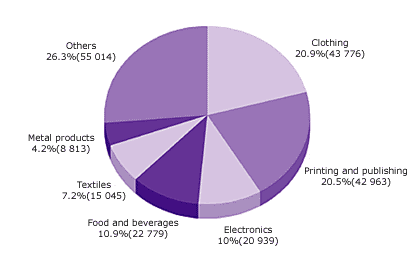The Manufacturing Sector
Automation, technology upgrading and relocation of lower
value-added operations to the Mainland have accelerated the development
of more knowledge-based and higher value-added manufacturing, as well
as manufacturing-related services or producer services. Expansion of manufacturing
activities offshore since the 1980s has turned Hong Kong into a strategic
control centre of an increasingly globalised production network. In spite
of the structural change, the manufacturing sector remained an important
sector of the economy, providing employment to
![]()
![]()
![]()
![]() The clothing industry was the largest employer in the manufacturing sector in 2001, followed by the printing and publishing industries. Chart 2 shows the breakdown of employment within the manufacturing sector in 2001.
The clothing industry was the largest employer in the manufacturing sector in 2001, followed by the printing and publishing industries. Chart 2 shows the breakdown of employment within the manufacturing sector in 2001.
|
|
|
|
 |
|
* As at September
|
![]()
![]()
![]()
![]() The manufacturing sector remains export-oriented and its excellent performance contributed to Hong Kong's ranking as one of the world's leading exporters of textiles, clothing, watches and clocks, toys and jewellery.
The manufacturing sector remains export-oriented and its excellent performance contributed to Hong Kong's ranking as one of the world's leading exporters of textiles, clothing, watches and clocks, toys and jewellery.
![]()
![]()
![]()
![]() The
manufacturing sector is dominated by small and medium enterprises (SMEs).
Of the
The
manufacturing sector is dominated by small and medium enterprises (SMEs).
Of the